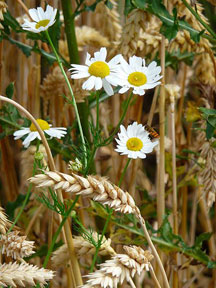The Parables of Christ, Part VI: Parable of the Wheat and Tares
 by Fr. James B. Buckley, FSSP
by Fr. James B. Buckley, FSSP
From the May 2011 Newsletter
Our Lord introduces the parable of the wheat and the cockle by saying that “the kingdom of heaven is like a man who sowed good seed in his field.” The kingdom of heaven is the Church which Christ established for the salvation of all men and not only for the Jews. When in His explanation of the parable Our Lord identifies the field as the world, He is indicating the divine intention to save all men (cf. I Tim. 2:4). However, as Father Leopold Fonck, S.J. wrote: “But as unbelievers have rejected this kingdom, our divine Redeemer will regard the Faithful in their visible community which He himself founded as His special kingdom of Heaven, and it is in this more restricted sense that He applies the image in this parable” (Parables of the Gospel, p. 140).
This parable, as St. Thomas Aquinas observed, explains the origins of the good and the evil in the Church, their intermingling in this life and their final separation in the next. In the words of Monsignor Ronald Knox, it “is an answer to the question, ‘Do all Christians go to Heaven?’ And the answer is ‘No’.”
Just as in the parable, the wheat resulted from the good seed sown by the farmer and the cockle from what was sown over the wheat by his enemy, so Christ’s word brings into His Church those “who are born… of the will of God” but the devil through his blandishments seduces some in that Church from their allegiance to Christ.
The cockle in the parable was allowed to grow together with the wheat because uprooting it would certainly also destroy the wheat. Saint Thomas comments that the good can exist without the evil but the evil cannot exist without the good; therefore, he says, the Lord tolerates many who are evil so that the many who are good may not perish.
Furthermore, St. Thomas gives reasons why on account of the good members of the Church the evil ones should not be removed before the Judgment. One reason is that those who are evil provide the good with opportunities for the practice of virtue, especially that of patience. Secondly, it does happen that one who was once evil afterwards becomes good. If Saul who had persecuted the Church of God had been extirpated, the Church would not have had Paul, the Apostle to the Gentiles. Thirdly, there are many who seem to be evil but are in reality good. If these were destroyed, the good would be destroyed.
In the parable the final separation of the wheat and the cockle takes place at the harvest; the wheat is placed in the farmer’s barn and the cockle bound “in bundles to burn.” In His explanation Our Lord says that at the end of the world the angels “shall gather out of his kingdom… them that work iniquity. And shall cast them into the furnace of fire…Then shall the just shine as the sun, in the kingdom of their Father” (cf. Matt. 13:39–43). The importance of this teaching cannot be overestimated for Catholics of our day who have heard from false teachers either that there is no hell or that no one goes there.
Indeed the final separation of the good and the evil who had been together in the Church is emphasized by its appearance in a companion parable found in the same thirteenth chapter of St. Matthew’s Gospel: “Again the kingdom of heaven is like to a net cast into the sea, and gathering together of all kind of fishes. Which when it was filled, they drew out, and sitting by the shore, they chose out the good into vessels but the bad they cast forth.
“So shall it be at the end of the world. The angels shall go out, and shall separate the wicked from the just” (Matt. 13:47–49).
These two parables force us to reflect on the words of St. Augustine who said that God, who made us without our willing it and who redeemed us without our willing it, will not save us unless we will it.
May 5, 2011








